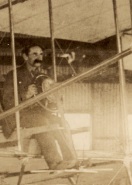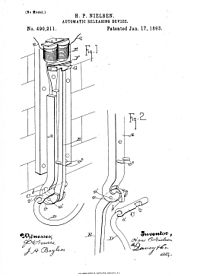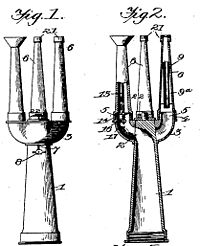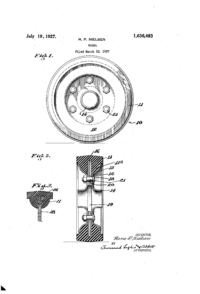H.P. Nielsen facts for kids
Quick facts for kids
H. P. Nielsen
|
|
|---|---|
| Born | 21 May 1859 Denmark
|
| Died | 11 September 1945 (aged 86) |
| Resting place | Grave at Mountain View Cemetery, Oakland, California |
| Citizenship | Danish (1859-1892) American (1892-death) |
| Occupation | Firefighter Engineer Inventor Mechanic Machinist |
| Employer | Self Alameda Fire Department Municipal Electric Light Plant HP Nielsen & Son |
| Known for | Building the first biplane in Alameda, California in 1910 |
| Spouse(s) |
Hansine Christine
(m. 1883)Lilly Palmer
(m. 1933) |
| Children | Augusta, Christian, Ella, Adolph |
| Signature | |
| Notes | |
|
Charter member of the Alameda Loyal Order of Moose
Charter member of the Fraternal Order of Eagles |
|
Hans Peter Nielsen (born May 21, 1859 – died September 11, 1945) was a clever inventor and engineer. He was born in Denmark but lived most of his life in Alameda, California. In 1910, Nielsen built the first biplane in Alameda. This was a big deal because he believed that flying would become very common. He thought that soon, people would fly their own planes to places like the Panama-Pacific exposition in San Francisco!
Nielsen was also a firefighter who created new tools to help fight fires. He was the first engineer at the Alameda Electric Light Plant. People in Alameda often read about his activities in local newspapers.
Contents
Life in Alameda
Hans Peter Nielsen was born in Denmark in 1859. He married Hansine Christine in 1883. The next year, he visited the United States for the first time. In 1887, he, Hansine, and their two children, Augusta and Christian, moved to San Francisco. They soon settled in Alameda. Nielsen became an American citizen on July 27, 1892. He and Hansine had two more children in California: Ella and Adolph.
Nielsen's Exciting Career
Firefighting Hero
Nielsen joined the Alameda Fire Department in 1890. He was the city's first paid firefighter! He worked as an engineer for the Encinal Steamer No. 1. This was a horse-drawn fire engine that used steam to pump water. Nielsen was known for getting the steam pumper ready faster than anyone else. He even used a little bit of gunpowder to speed things up!
Electric Power Pioneer
In 1901, Nielsen left the Fire Department. He became the first engineer at the Alameda Electric Light Plant. This company is the oldest city-owned electric company west of the Mississippi River. From 1887 to 1902, it provided street lights for Alameda. Later, it also started providing electricity to homes and businesses.
Automobile Mechanic
Nielsen also owned the Encinal Garage in Alameda. Here, he repaired cars. In 1909, he got permission to build a machine shop behind his home. Even while he was busy building flying machines, his garage was so busy that he hired extra help.
In 1912, the city of Alameda hired Nielsen to build a special tractor. This tractor would pull the Fire Station No. 1 hook-and-ladder truck. The tractor had pneumatic front tires and a powerful 35-horsepower engine. It could pull the truck at 20 miles per hour! Plus, the engine could be detached quickly. This meant the truck could still be pulled by horses if needed.
Building Airplanes
Nielsen was very interested in the new science of flying. He carefully studied planes flown by famous pilots like Louis Paulhan. He even drew designs for several aircraft. However, he didn't have enough money to build them himself.
In 1910, he met a businessman named Adrian J Merle. Merle had recently flown as a passenger in a plane and was excited about building aircraft. With Merle's financial help, Nielsen announced in January 1910 that he would start building airplanes.
Nielsen planned to build two biplanes and one monoplane. He thought the first plane would be ready in two months. It would be a "plane for pleasure" that was fast and safe. It would be about 30 feet wide and could carry two passengers.
Building Merle's biplane took longer than expected. By September, Nielsen was in a race with another engineer, William Gorham, to build Alameda's first working airplane. Nielsen's plane was much larger and heavier. It had a 45-horsepower engine and a huge wing area. Nielsen designed his plane to fly slowly, making it safer for new pilots.
Merle tested Nielsen's biplane in September 1910. The plane was too heavy to fly for long, only staying in the air for a few hundred feet at a time. It was later taken apart and never flew again. Nielsen is not known to have built any other aircraft.
Nielsen's Clever Inventions
Firefighting Tools
Nielsen is sometimes called the "father" of the modern fog-spray fire hose nozzle. This type of nozzle is now used to fight oil and gasoline fires.
In 1892, Nielsen created a device to quickly unhitch horses from fire engines. This was very important for getting to fires fast! He received US Patent 490211 for this invention in 1893.
Nielsen and Alameda Fire Chief Frederick Keller Krauth, Jr. also invented an improved Hose Nozzle in 1897. Their design allowed firefighters to switch between a single stream, a double stream, and a wider spray. This was an early version of the modern adjustable fog nozzle.
Workshop Creations
In 1898, Nielsen invented an Acetylene Gas Generator. This device was designed for cars and portable lamps. It used calcium carbide to make gas and also to dry the gas. When the carbide ran out, the machine would stop the water flow and sound an alarm. When he received US Patent 648283 in 1900, local newspapers celebrated his "gas generator."
Caster Wheel Designs
In the late 1920s, Nielsen invented several improvements for caster wheels. These are the wheels that let furniture or carts roll easily in any direction. Nielsen worked with the Eames Company of San Francisco, which made "invalid chairs" (wheelchairs) and other wheeled products. This company was owned by Adrian J Merle, the same person for whom Nielsen had built the biplane!
In 1927, Nielsen patented an improved caster wheel (US Patent 1636483). This wheel was designed to handle heavy loads better. He also patented a swivel caster with ball bearings (US Patent 1749502) and a brake for caster wheels (US Patent 1785421).
Personal Life and Challenges
Nielsen and his family were often in the news. People were interested in his inventions, but also in his accidents and other life events.
Accidents and Mishaps
Nielsen had several accidents. In 1900, he was injured when he fell from a ladder at work.
In 1904, Nielsen and his daughter Augusta were almost in a serious car accident. Nielsen lost control of his car on a steep road. Augusta was thrown from the car but was not hurt. Nielsen landed in bushes and barbed wire, getting minor injuries.
In 1905, Nielsen's car was trampled by steers (young bulls) while he was driving near Sacramento. He was injured, and his car was badly damaged. But he managed to fix it enough to drive home, even using a gas lamp as a headlight!
In 1928, at age 69, Nielsen was working on his car in his garage. A jack slipped, crushing his hand.
Standing Up for Himself
In 1913, Nielsen refused to pay a business license fee for being an automobile mechanic. He argued that it was unfair because other manual workers like blacksmiths and carpenters didn't have to pay such a fee. He was arrested but demanded a jury trial. He believed that if a judge didn't have to pay a license to be a judge, he shouldn't have to pay one for repairing cars. He was released after paying a bond.
Later Life
Nielsen's first wife, Hansine, passed away in 1925. In 1933, at the age of 78, Nielsen married Lilly Palmer. They married in Reno, which was a place where couples could marry quickly.








